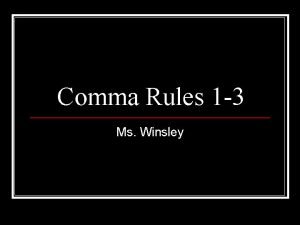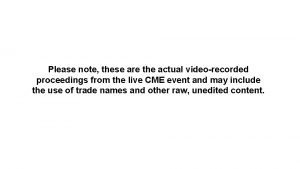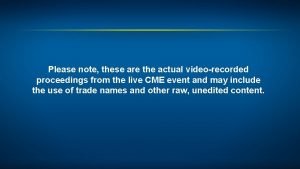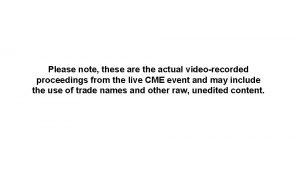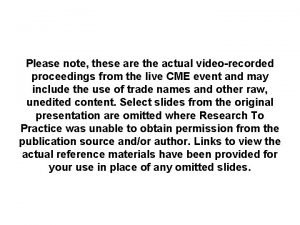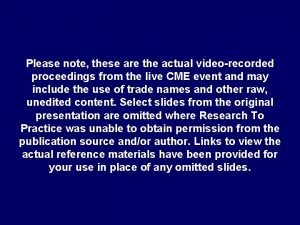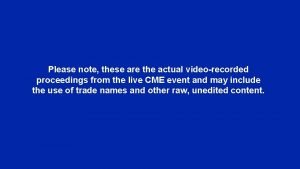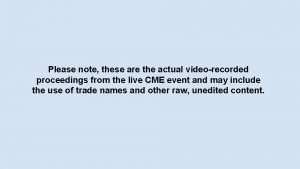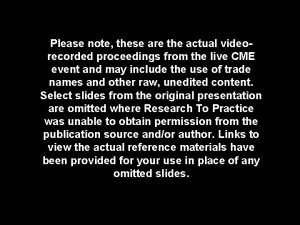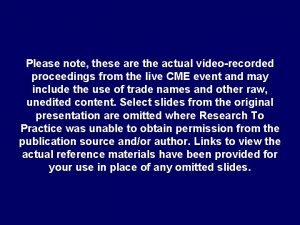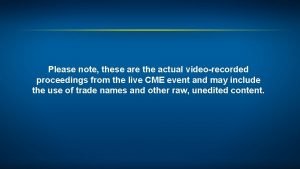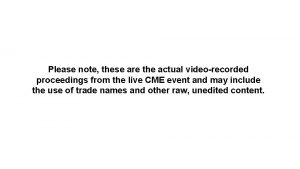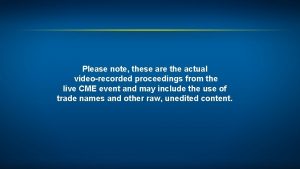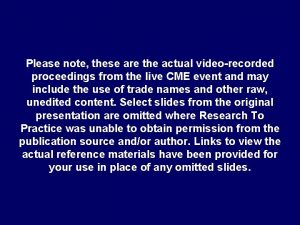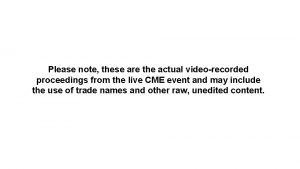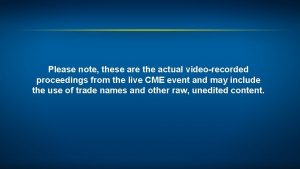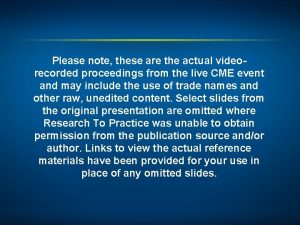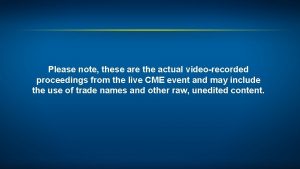Please note these are the actual videorecorded proceedings


















































- Slides: 50

Please note, these are the actual video-recorded proceedings from the live CME event and may include the use of trade names and other raw, unedited content.

Module 12: Renal Cell and Bladder Cancer Drs Quinn and Plimack

Do you have any patients in your practice with. . . % responding “yes” Median among those responding “yes” Metastatic renal cell carcinoma 94% 5 Nonmetastatic renal cell carcinoma 82% 3 Metastatic bladder cancer 80% 4 Nonmetastatic bladder cancer 80% 3 Survey of general medical oncologists, February 2019

USE OF NEW AGENTS/STRATEGIES Have you administered the following (on or off a clinical trial) to a patient with renal cell carcinoma? % responding “yes” Median among those responding “yes” Anti-PD-1/PD-L 1 antibody in combination with an anti-CTLA-4 antibody 76% 2 Cabozantinib 71% 2 Survey of general medical oncologists, February 2019

USE OF NEW AGENTS/STRATEGIES Have you administered the following (on or off a clinical trial) to a patient with bladder cancer? % responding “yes” Median among those responding “yes” 63% 2 Anti-PD-1/PD-L 1 antibody as first-line treatment for metastatic disease Survey of general medical oncologists, February 2019

Renal Cell Cancer Miami, Feb 2019 David I Quinn MBBS (Hons) Ph. D FRACP FACP Associate Professor of Medicine Chief, Section of GU Medical Oncology Division of Medical Oncology Medical Director, Norris Cancer Hospital & Clinics Member, USC Institute of Urology Kenneth J. Norris Comprehensive Cancer Center Keck School of Medicine University of Southern California

Disclosures Astellas Pharma Global Development Inc, Astra. Zeneca Pharmaceuticals LP, Bayer Health. Care Pharmaceuticals, Bristol-Myers Squibb Company, Advisory Committee and Celgene Corporation, Clovis Oncology, Dendreon Consulting Agreements Pharmaceuticals Inc, Exelixis Inc, Genentech, Janssen Biotech Inc, Merck, Novartis, Pfizer Inc, Roche Laboratories Inc, Sanofi Genzyme Contracted Research Astellas Pharma Global Development Inc, Bayer Health. Care Pharmaceuticals, Bristol-Myers Squibb Company, Genentech, Merck, Pfizer Inc Data and Safety Monitoring Board/Committee Eisai Inc, US Biotest Inc

Check. Mate 214: Phase 3 Study of Nivolumab + Ipilimumab vs Sunitinib in 1 L Advanced/Metastatic RCC 1, 2 N=1070 Eligibility: • Adv/metastatic (AJCC Stage 4) RCC • No prior systemic Tx for RCC unless 1 prior adjuvant/neoadjuvant Tx (no VEGF/VEGFR targeted therapy) • KPS ≥ 70% • Measurable disease (RECIST 1. 1 defined) • Tumor tissue available for PD-L 1 testing Nivolumab 3 mg/kg + Ipilimumab 1 mg/kg q 3 w for 4 w, then Nivolumab 3 mg/kg IV q 2 w Until disease progression or unacceptable toxicity R 1: 1 Sunitinib 50 mg PO qd 4 weeks on, 2 weeks off Primary Outcome Measure: PFS, ORR Secondary Outcome Measures: Safety Key Exploratory Measures: antitumor activity (ORR, PFS, OS) in favorable risk patients, outcomes by tumor PD-L 1 expression level, health-related Qo. L based on FKSI-19 1. Escudier B et al. Oral Presentation at ESMO 2017. LBA 5. 2. Clinicaltrials. gov. NCT 02231749. Accessed February 2019.

Check. Mate 214: OS in IMDC Intermediate- /Poor-Risk Patients Median follow-up: 25. 2 months OS in IMDC Intermediate/Poor Risk Patients Median OS, months (95% CI)) Overall Survival (Probability) 1. 0 0. 9 NIVO + IPI NR (28. 2–NE) SUN 26. 0 (22. 1–NE) Hazard ratio (99. 8% CI), 0. 63 (0. 44– 0. 89) P<0. 0001 0. 8 0. 7 0. 6 0. 5 0. 4 0. 3 0. 2 0. 1 0. 0 0 3 6 9 12 18 21 24 27 30 33 119 89 44 34 2 3 0 0 Time (months) No. at Risk NIVO + IPI SUN 15 422 399 387 372 352 348 315 332 288 318 253 300 225 241 179 Adapted from Escudier et al, 2017. *Pneumonitis, immune mediated bronchitis, lower GI hemorrhage, hemophagocytic syndrome, sudden death, liver toxicity, lung infection. †Cardiac arrest (n = 2), heart failure, multiple organ failure. Escudier B et al. Oral Presentation at ESMO 2017. LBA 5.

Check. Mate 214: OS by Tumor PD-L 1 Expression in IMDC Intermediate/Poor-Risk Patients Overall Survival (Probability) PD-L 1 <1% (n = 562) PD-L 1 ≥ 1% (n = 214) 1. 0 0. 9 0. 8 0. 7 0. 6 0. 5 Median OS (95% CI), months 0. 4 NIVO + IPI SUN 0. 3 Median OS (95% CI), months 0. 4 NR (28. 2–NE) NR (24. 0–NE) NIVO + IPI SUN 0. 3 0. 2 HR (95% CI), 0. 73 (0. 56– 0. 96) P = 0. 0249 0. 1 NR (NE–NE) 19. 6 (14. 8–NE) HR (95% CI), 0. 45 (0. 29– 0. 71) P <0. 001 0. 0 0 3 6 9 12 18 21 24 27 30 33 0 3 6 9 12 Months No. at Risk NIVO + IPI 284 SUN 278 15 15 18 21 24 27 30 Months 251 223 200 76 0 100 87 83 76 33 2 239 198 157 61 1 114 90 72 55 21 2 Motzer RJ et al. Oral presentation at SITC 2017. Abstract O 38. 33

Check. Mate 214: ORR and PFS in IMDC Favorable-Risk Patients N = 249* Outcome NIVO + IPI N = 125 SUN N = 124 Confirmed ORR, † % (95% CI) 29 (21 -38) 52 (43 -61) P = 0. 0002 PFS, ‡ median (95% CI), months 15. 3 (9. 7 -20. 3) 25. 1 (20. 9 -NE) HR (99. 1% CI) 2. 18 (1. 29 -3. 68) P < 0. 0001 Only 26 of 249 pts who are PD-L 1 positive in good risk group *11% of patients in both arms had tumor PD-L 1 expression ≥ 1%. †IRRC-assessed by RECIST v 1. 1. ‡IRRC-assessed. Escudier B et al. Oral presentation at ESMO 2017. LBA 5

Memorial Sloan Kettering Cancer Center (MSKCC/Motzer) Score for Metastatic Renal Cell Carcinoma (RCC) Predicted outcomes Score Risk Median survival 0 Good 20 months 1 -2 Intermediate 10 months ≥ 3 High 4 months This nomogram is often used for selecting patients to enroll in clinical trials. The score retrospectively identified some variables associated with survival, which may ultimately help predict outcomes. https: //www. mdcalc. com/memorial-sloan-kettering-cancer-center-mskcc-motzer-scoremetastatic-renal-cell-carcinoma-rcc

Alliance A 031203/CABOSUN: Randomized Phase II Trial of First-line Cabozantinib vs Sunitinib in Intermediate- or Poor -Risk Patients With Advanced RCC 1 Cabozantinib 60 mg qd orally • • • Advanced RCC (N=157) Clear cell component Measurable disease No prior systemic therapy ECOG PS 0 -2 IMDC intermediate- or poor-risk groups CNS metastases allowed if adequately treated and stable for 3 months (6 -week cycles) Randomization 1: 1 No crossover allowed Sunitinib 50 mg qd orally Tumor assessment by RECIST v 1. 1 every 12 weeks Treatment until disease progression or intolerable toxicity (4 weeks on/2 weeks off) Primary endpoint § PFS by investigator assessment Secondary endpoints § OS, ORR, safety Stratification § IMDC risk group 2: intermediate, poor § Bone metastases: yes, no ECOG PS=Eastern Cooperative Oncology Group performance status; IMDC=International Metastatic Renal Cell Carcinoma Database Consortium; qd=once daily; RECIST=Response Evaluation Criteria in Solid Tumors. 1. Choueiri TK, et al. J Clin Oncol. 2017; 35: 591 -597. 2. Heng DY, et al. J Clin Oncol. 2009; 27: 5794 -5799.

Alliance A 031203/CABOSUN: Kaplan-Meier Plot of PFS per IRC Data cutoff: September 15, 2016. IRC=independent radiology committee; mo=months. Choueiri TK, et al. Poster. ESMO. 2017 (abstr LBA 38).

Alliance A 031203/CABOSUN: Overall Survival Data cutoff: July 1, 2017. IRC=independent radiology committee; mo=months; NE=not evaluable. Choueiri TK, et al. Poster. ESMO. 2017 (abstr LBA 38).

IMmotion 151: Study Design Key Eligibility: • Treatment-naive advanced or metastatic RCC • Clear cell and/or sarcomatoid histology • KPS ≥ 70 • Tumor tissue available for PD-L 1 staining Atezolizumab 1200 mg IV q 3 w b + Bevacizumab 15 mg/kg IV q 3 w b Stratification: • MSKCC risk score • Liver metastases • PD-L 1 IC IHC status (< 1% vs ≥ 1%)a N = 915 R 1: 1 Primary Endpoints PFS by investigator-assessment in PD-L 1+ patients OS in ITT a ≥ 1% IC: 40% prevalence using SP 142 IHC assay; b No dose reduction for atezolizumab or bevacizumab. Motzer RJ et al. GU Symposium 2018; J Clin Oncol 36, 2018 (suppl 6 S; abstr 578) Sunitinib 50 mg/day orally (4 wk on, 2 wk off)

IMmotion 151: Progression-Free Survival in the Intention -to-Treat (ITT) and PD-L 1 -Positive Populations PD-L 1+ Population Progression-free survival ITT Population Months ITT population N Median PFS (mo) HR Atezo + Bev 454 11. 2 0. 83 Sunitinib 461 8. 4 PD-L 1+ population N Median PFS (mo) HR Atezo + Bev 178 11. 2 0. 74 Sunitinib 184 7. 7 Motzer RJ et al. Genitourinary Cancers Symposium 2018; Abstract 578.

JAVELIN RENAL 101: Phase III Study of Avelumab in Combination With Axitinib vs Sunitinib Monotherapy in Treatment-naïve Patients With Advanced RCC • • Selected Eligibility Criteria (N=886) Treatment-naïve, advanced RCC with a clear cell component ≥ 1 measurable lesion as defined by RECIST v 1. 1 Tumor tissue available for PD-L 1 staining ECOG PS 0 or 1 Avelumab 10 mg/kg IV q 2 w + Axitinib 5 mg po bid (6 -week cycle) R 1: 1 Sunitinib 50 mg po qd (4 weeks on/2 weeks off) Primary Endpoints: PFS assessed by IRC in PD-L 1+ group*, OS in PD-L 1+ group* Key Secondary Endpoints: PFS per IRC in overall population, OS in overall population Secondary Endpoints: ORR, DCR, TTR, DOR, safety, PK, PRO, ADA relationship between treatment response and tumor or blood biomarkers, immune-related PFS, ORR, DCR, TTR, and DOR per immune-related RECIST Stratification: ECOG PS (0 vs 1) and geographic region (US, Canada/Western Europe, rest of the world) Statistical Analyses: • For the primary PFS endpoint, 336 events would provide 90% power to detect a HR of 0. 65 at significance level of 0. 004. • A gatekeeping strategy, which tested the overall population only if PFS in the PD-L 1+ group was significant, was used to control for type 1 error. • Interim analysis was planned for approximately 235 PFS events (70% of total required PFS events) in the PD-L 1+ group. bid=twice a day; ECOG=Eastern Cooperative Oncology Group; PK=pharmacokinetics; PO=orally; PRO=patient-reported outcomes; qd=every day; RECIST=Response Evaluation Criteria in Solid Tumors; TKI=tyrosine kinase inhibitor. * ≥ 1% PD-L 1 expression on tumor-infiltrating immune cells using Ventana PD-L 1 (SP 263) IHC assay Motzer RJ, et al. Presented at ESMO. 2018 (abstr LBA 6_PR). https: //clinicaltrials. gov/ct 2/show/NCT 02684006

JAVELIN RENAL 101: PFS per IRC PD-L 1+ group Overall population PD-L 1+ group: Minimum follow-up, 6 months. Median follow-up, 9. 9 months (avelumab + axitinib) and 8. 4 months (sunitinib). Overall population: Minimum follow-up, 6 months. Median follow-up, 10. 8 months (avelumab + axitinib) and 8. 6 months (sunitinib). The PFS analysis crossed the prespecified efficacy boundary based on the alpha-spending function (P=. 001) Motzer RJ, et al. Presented at ESMO. 2018 (abstr LBA 6_PR).

JAVELIN RENAL 101: OS in Overall Population Median follow-up, 12. 0 months (avelumab + axitinib) and 11. 5 months (sunitinib). Motzer RJ, et al. Presented at ESMO. 2018 (abstr LBA 6_PR).

KEYNOTE-426 Study Design Powles T et al. Genitourinary Cancers Symposium 2019; Abstract 543.

KEYNOTE-426: Overall Survival 12 -mos survival rate Rini BI et al. NEJM 2019 Feb 16; Epub ahead of print Pembro-Axitinib (n = 432) Sunitinib (n = 429) 89. 9% 78. 3%

KEYNOTE-426: Progression-Free Survival Median PFS Pembro-Axitinib (n = 432) Sunitinib (n = 429) 15. 1 mo 11. 1 mo Rini BI et al. NEJM 2019 Feb 16; Epub ahead of print

David Quinn’s Preferred Therapeutic Sequencing and Decision Points For Metastatic RCC 2019 Baseline: Cytoreductive Nephrectomy; Control Critical Metastases: Brain, Bone; General health measures: TSH, Vitamin D Interleukin-2, HDΨ Nivolumab + Ipi Pazopanib Sunitinib Nivolumab Axitinib Sorafenib Cabozantinib Everolimus + Lenvatinib Everolimus Temsirolimus* Bevacizumab Ψhighly selected patients ? VEGF + CPI

Module 12: Renal Cell and Bladder Cancer Drs Quinn and Plimack

Urothelial Bladder Cancer Elizabeth R Plimack MD MS Chief, Division of Genitourinary Medical Oncology Director, Genitourinary Clinical Research Associate Professor, Hematology/Oncology Fox Chase Cancer Center, Temple Health

Disclosures Advisory Committee Bristol-Myers Squibb Company, Genentech, Incyte Corporation, Janssen Biotech Inc, Merck Contracted Research Astellas Pharma Global Development Inc, Astra. Zeneca Pharmaceuticals LP, Bristol-Myers Squibb Company, Genentech, Merck, Peloton Therapeutics Inc, Pfizer Inc Data and Safety Monitoring Board/Committee Astra. Zeneca Pharmaceuticals, Pfizer Inc

Checkpoint inhibitors US FDA approved for UC Agent Ab Inhibits: Schedule Post Platinum Frontline Cisineligible atezolizumab PD-L 1 Q 3 Weeks accelerated Nivolumab PD-1 Q 4 Weeks accelerated - Durvalumab PD-L 1 Q 2 Weeks accelerated - Avelumab PD-L 1 Q 2 Weeks accelerated - Pembrolizumab PD-1 Q 3 Weeks Level 1 accelerated Ribas NEJM 2012

First Line Systemic Therapy for Metastatic Disease

Cisplatin based chemo for UC yields durable responses. Cis is the original “tail on the curve” Cisplatin Eligible Gemcitabine Cisplatin ORR 49% CR 12 % m. OS 14 mo Dose Dense MVAC ORR 72% CR 25% m. OS 15. 1 mo Gemcitabine Carboplatin ORR 36% CR 3% m. OS 9. 3 mo Von Der Masse et al. JCO, 2005 Sternberg CN et al. Eur J Cancer, 2006 De Santis M et al. J Clin Oncol. 2012

Atezolizumab first line cisplatin ineligible n=119 patients Median F/up: 29. 3 months Overall Response Rate: 24% Median OS: 16. 3 months 58% alive at 12 months Balar, et al. ASCO 2018

Pembrolizumab in first line cisplatin ineligible pts n=370 patients Median F/up: 17 months Overall Response Rate: 29% Median OS: 11. 5 months 48% Alive at 12 months Vuky, et al. ASCO 2018

Response Rates to First Line Therapy for Metastatic Urothelial Carcinoma 100% Partial Response Complete Response 90% 80% 70% 60% 50% 40% 30% 20% 10% 0% DD MVAC Sternberg EJC 2006 Gem Cis von der Masse JCO 2000 CISPLATIN ELIGIBLE Gem Carbo De Santis JCO 2012 Pembrolizumab Vukey ASCO 2018 Atezolizumab Balar ASCO 2018 CISPLATIN IN-ELIGIBLE

May 18 2018 FDA warning FDA Alerts Health Care Professionals and Oncology Clinical Investigators about an Efficacy Issue Identified in Clinical Trials for Some Patients Taking Pembrolizumab or Atezolizumab as Monotherapy to Treat Urothelial Cancer with Low Expression of PD-L 1 • • • [5/18/2018] The U. S. Food and Drug Administration is alerting health care professionals, oncology clinical investigators, and the public about decreased survival associated with the use of pembrolizumab or atezolizumab as single therapy (monotherapy) in clinical trials to treat patients with metastatic urothelial cancer who have not received prior therapy and who have low expression of the protein programmed death ligand 1 (PD-L 1). In two ongoing clinical trials (KEYNOTE-361 and IMVIGOR-130), the Data Monitoring Committees’ (DMC) early reviews found patients in the monotherapy arms of both trials with PD-L 1 low status had decreased survival compared to patients who received cisplatin- or carboplatin-based chemotherapy. There was no change in the adverse event profile of pembrolizumab or atezolizumab. Both Merck, manufacturer of pembrolizumab, and Genentech, manufacturer of atezolizumab, have stopped enrolling patients whose tumors have PD-L 1 low status to the pembrolizumab or atezolizumab monotherapy arms per the DMCs’ recommendations. The clinical trials compare platinum-based chemotherapy combined with pembrolizumab or atezolizumab to platinum-based chemotherapy alone. Both trials enrolled a third arm of monotherapy with pembrolizumab or atezolizumab to compare to platinum-based chemotherapy alone. The monotherapy arms remain open only to patients whose tumors have PD-L 1 high status. The combination arms and the chemotherapy arms of both studies also remain open. The FDA is reviewing the findings of the ongoing clinical trials and will communicate new information as necessary. Both pembrolizumab and atezolizumab are currently approved under accelerated approval for the treatment of locally advanced or metastatic urothelial carcinoma patients who are not eligible for cisplatin-containing chemotherapy, irrespective of PD-L 1 status. Patients taking pembrolizumab or atezolizumab for other approved uses should continue to take their medication as directed by their health care professional. Health care professionals should be aware that the populations enrolled in the ongoing clinical trials were eligible for platinum-containing chemotherapy, and therefore differ from those enrolled in the trials that led to the accelerated approvals of both pembrolizumab and atezolizumab in the treatment of patients with locally advanced or metastatic urothelial carcinoma who are not eligible for cisplatin-containing chemotherapy. FDA recommends providers select patients for the treatment of locally advanced or metastatic urothelial cancer using the criteria described in Section 14 of each label. These criteria supported the approvals for pembrolizumab and atezolizumab for initial monotherapy in cisplatin-ineligible patients. Pembrolizumab and atezolizumab are also currently approved by the FDA for the treatment of multiple types of other cancers. Patients should talk to their doctor if they have questions or concerns about either drug. Health care professionals and patients are encouraged to report any adverse events or side effects related to the use of these products and other similar products to FDA’s Med. Watch Adverse Event Reporting program.

The studies cited compare monotherapy to Alert! decreased survival associated with the use of platinum chemotherapy pembrolizumab or atezolizumab as monotherapy in clinical trials of patients with metastatic urothelial cancer who have not received prior therapy and who have low expression of PD-L 1 FDA Alerts Health Care Professionals and Oncology Clinical Investigators about an Efficacy Issue However… Identified in Clinical Trials for Some Patients Taking pembrolizumab (pembrolizumab) or May 18 2018 FDA warning atezolizumab as Monotherapy to Treat Urothelial Cancer with Low Expression of PD-L 1 • • • [5/18/2018] The U. S. Food and Drug Administration is alerting health care professionals, oncology clinical investigators, and the public about decreased survival associated with the use of pembrolizumab or atezolizumab as single therapy (monotherapy) in clinical trials to treat patients with metastatic urothelial cancer who have not received prior therapy and who have low expression of the protein programmed death ligand 1 (PD-L 1). In two ongoing clinical trials (KEYNOTE-361 and IMVIGOR-130), the Data Monitoring Committees’ (DMC) early reviews found patients in the monotherapy arms of both trials with PD-L 1 low status had decreased survival compared to patients who received cisplatin- or carboplatin-based chemotherapy. There was no change in the adverse event profile of pembrolizumab or atezolizumab. Both Merck, manufacturer of pembrolizumab, and Genentech, manufacturer of atezolizumab, have stopped enrolling patients whose tumors have PD-L 1 low status to the pembrolizumab or atezolizumab monotherapy arms per the DMCs’ recommendations. The clinical trials compare platinum-based chemotherapy combined with pembrolizumab or atezolizumab to platinum-based chemotherapy alone. Both trials enrolled a third arm of monotherapy with pembrolizumab or atezolizumab to compare to platinum-based chemotherapy alone. The monotherapy arms remain open only to patients whose tumors have PD-L 1 high status. The combination arms and the chemotherapy arms of both studies also remain open. The FDA is reviewing the findings of the ongoing clinical trials and will communicate new information as necessary. Both pembrolizumab and atezolizumab are currently approved under accelerated approval for the treatment of locally advanced or metastatic urothelial carcinoma patients who are not eligible for cisplatin-containing chemotherapy, irrespective of PD-L 1 status. Patients taking pembrolizumab or atezolizumab for other approved uses should continue to take their medication as directed by their health care professional. Health care professionals should be aware that the populations enrolled in the ongoing clinical trials were eligible for platinum-containing chemotherapy, and therefore differ from those enrolled in the trials that led to the accelerated approvals of both pembrolizumab and atezolizumab in the treatment of patients with locally advanced or metastatic urothelial carcinoma who are not eligible for cisplatin-containing chemotherapy. FDA recommends providers select patients for the treatment of locally advanced or metastatic urothelial cancer using the criteria described in Section 14 of each label. These criteria supported the approvals for pembrolizumab and atezolizumab for initial monotherapy in cisplatin-ineligible patients. Pembrolizumab and atezolizumab are also currently approved by the FDA for the treatment of multiple types of other cancers. Patients should talk to their doctor if they have questions or concerns about either drug. Health care professionals and patients are encouraged to report any adverse events or side effects related to the use of these products and other similar products to FDA’s Med. Watch Adverse Event Reporting program.

The studies cited compare monotherapy to Alert! decreased survival associated with the use of platinum chemotherapy pembrolizumab or atezolizumab as monotherapy in clinical trials of patients with metastatic urothelial cancer who have not received prior therapy and who have low expression of PD-L 1 FDA Alerts Health Care Professionals and Oncology Clinical Investigators about an Efficacy Issue However… Identified in Clinical Trials for Some Patients Taking pembrolizumab (pembrolizumab) or May 18 2018 FDA warning atezolizumab as Monotherapy to Treat Urothelial Cancer with Low Expression of PD-L 1 • • • [5/18/2018] The U. S. Food and Drug Administration is alerting health care professionals, oncology clinical investigators, and the public about decreased survival associated with the use of pembrolizumab or atezolizumab as single therapy (monotherapy) in clinical trials to treat patients with metastatic urothelial cancer who have not received prior therapy and who have low expression of the protein programmed death ligand 1 (PD-L 1). In two ongoing clinical trials (KEYNOTE-361 and IMVIGOR-130), the Data Monitoring Committees’ (DMC) early reviews found patients in the monotherapy arms of both trials with PD-L 1 low status had decreased survival compared to patients who received cisplatin- or carboplatin-based chemotherapy. There was no change in the adverse event profile of pembrolizumab or atezolizumab. Both Merck, manufacturer of pembrolizumab, and Genentech, manufacturer of atezolizumab, have stopped enrolling patients whose tumors have PD-L 1 low status to the pembrolizumab or atezolizumab monotherapy arms per the DMCs’ recommendations. The clinical trials compare platinum-based chemotherapy combined with pembrolizumab or atezolizumab to platinum-based chemotherapy alone. Both trials enrolled a third arm of monotherapy with pembrolizumab or atezolizumab to compare to platinum-based chemotherapy alone. The monotherapy arms remain open only to patients whose tumors have PD-L 1 high status. The combination arms and the chemotherapy arms of both studies also remain open. The FDA is reviewing the findings of the ongoing clinical trials and will communicate new information as necessary. Both pembrolizumab and atezolizumab are currently approved under accelerated approval for the treatment of locally advanced or metastatic urothelial carcinoma patients who are not eligible for cisplatin-containing chemotherapy, irrespective of PD-L 1 status. Patients taking pembrolizumab or atezolizumab for other approved uses should continue to take their medication as directed by their health care professional. Health care professionals should be aware that the populations enrolled in the ongoing clinical trials were eligible for platinum-containing chemotherapy, and therefore differ from those enrolled in the trials that led to the accelerated approvals of both pembrolizumab and atezolizumab in the treatment of patients with locally advanced or metastatic urothelial carcinoma who are not eligible for cisplatin-containing chemotherapy. FDA recommends providers select patients for the treatment of locally advanced or metastatic urothelial cancer using the criteria described in Section 14 of each label. These criteria supported the approvals for pembrolizumab and atezolizumab for initial monotherapy in cisplatin-ineligible patients. Pembrolizumab and atezolizumab are also currently approved by the FDA for the treatment of multiple types of other cancers. Patients should talk to their doctor if they have questions or concerns about either drug. Health care professionals and patients are encouraged to report any adverse events or side effects related to the use of these products and other similar products to FDA’s Med. Watch Adverse Event Reporting program. Enrolled cisplatin eligible and ineligible patients.

June/July 2018: FDA and EMA restrict the indication for treatment 1 st line to pts who are cisplatin ineligible and PD-L 1+ FDA has limited the use of atezolizumab and pembrolizumab for patients with locally advanced or metastatic urothelial cancer who are not eligible for cisplatin-containing therapy. For pembrolizumab, pts must be cisplatin ineligible and PD-L 1+ by CPS The Agency took this action on June 19, 2018, due to decreased survival associated with the use of pembrolizumab (pembrolizumab) or atezolizumab (atezolizumab) as single therapy (monotherapy) compared to platinum-based chemotherapy in clinical trials to treat patients with metastatic urothelial cancer who have not received prior score [CPS ≥ 10] therapy and who have low expression of the protein programmed death ligand 1 (PD-L 1). The labels of both drugs have been revised to reflect the limitation in the indication. The indications read as follows: Pembrolizumab is indicated for the treatment of patients with locally advanced or metastatic urothelial carcinoma who are not eligible for cisplatin-containing therapy and whose tumors express PD-L 1 (Combined Positive Score ≥ 10), or in patients who are not eligible for any platinum-containing chemotherapy regardless of PD-L 1 status. Atezolizumab is indicated for the treatment of patients with locally advanced or metastatic urothelial carcinoma who: Are not eligible for cisplatin-containing therapy, and whose tumors express PD-L 1 (PD-L 1 stained tumor-infiltrating immune cells [IC] covering ≥ 5% of the tumor area), as determined by an FDA-approved test, or Are not eligible for any platinum-containing therapy regardless of PD-L 1 status. On July 2, 2018, the FDA approved the Ventana PD-L 1 (SP 142) Assay (Ventana Medical Systems, Inc. ) for PD‑L 1 expression in ≥ 5% IC in urothelial carcinoma tissue. The test should be used to select patients with locally advanced or metastatic urothelial carcinoma for treatment with atezolizumab (atezolizumab, Genentech Inc. ). The FDA also updated the Prescribing Information for atezolizumab to require use of an FDA-approved test for patient selection. For atezolizumab, pts must be cisplatin ineligible and PD-L 1+ by IC score [IC ≥ 5%] The tests used in the trial to determine PD-L 1 expression are listed in Section 14 of each drug label. The FDA is reviewing the findings of ongoing analyses and will communicate new information regarding the PD-L 1 assays and indications as it becomes available.

st Take Home Points: 1 line m. UC • Chemotherapy is highly active in this space • Cisplatin eligible patients should get cisplatin • Cisplatin ineligible patients should get gem carbo unless they are PD-L 1 positive using the specific companion diagnostic test* • Patients ineligible for any chemotherapy can be considered for checkpoint inhibitor therapy regardless of PD-L 1 status *Access to these specific companion diagnostic tests is highly variable and limited at many institutions

Breakthrough Therapies

Phase II Erdafitinib: oral pan-FGFR (1 -4) inhibitor • FGFR mutation or fusion required for enrollment (prevalence in met UC: 15 -20%) • At least 1 prior systemic therapy. Prior checkpoint allowed. Siefker Radtke ASCO 2018

Phase II Erdafitinib: oral pan-FGFR (1 -4) inhibitor • ORR 40%, m. OS 13. 8 months Siefker Radtke ASCO 2018

Enfortumab Vedotin Is an Antibody-Drug Conjugate Targeting Nectin-4 • Enfortumab vedotin (EV) is a fully humanized monoclonal antibody against Nectin-4 conjugated with the microtubule -disrupting agent monomethyl auristatin E by a protease‑cleavable linker • Nectin-4, a transmembrane cell adhesion molecule 1, was found to be highly expressed in 97% of m. UC patient samples 3 1 Samanta D and Almo SC. Cell Mol Life Sci. 2015; 72: 645– 658; 2 Challita-Eid PM et al. Cancer Res. 2016; 76: 3003– 3013; 3 Petrylak DP et al. J Clin Oncol. 2017; 35: 106– 106. Rosenberg ASCO 2018

Phase I EV-101 Trial of Enfortumab Vedotin in Metastatic Urothelial Cancer: Response A total of 103 patients had at least 1 measurable postbaseline response assessment Rosenberg JE et al. Genitourinary Cancers Symposium 2019; Abstract 377.

My Recommendations for UC in 2019 Neoadjuvant cisplatin eligible Preferred DDMVAC Alternate Gem Cis – standard dosing cisplatin ineligible Upfront Surgery Checkpoint inhibitor on a clinical trial First line metastatic cisplatin eligible Preferred DDMVAC Alternate Gem Cis – standard dosing cisplatin ineligible, PD-L 1+ Pembrolizumab atezolizumab cisplatin ineligible, PD-L 1 neg or unkn Carbo Gem / Clinical Trial Supportive Care / Clinical Trial Post Platinum Post DDMVAC Preferred Pembrolizumab Gem Taxane Alternate Gem, Taxane Post Gem Cis atezolizumab Taxane Post 1 st line Checkpoint Preferred Alternate cisplatin eligible (by definition) Gemcitabine +/- carbo Taxane

My Recommendations for UC in 2019 Neoadjuvant cisplatin eligible Preferred DDMVAC Alternate Gem Cis – standard dosing cisplatin ineligible Upfront Surgery Checkpoint inhibitor on a clinical trial First line metastatic cisplatin eligible Preferred DDMVAC Alternate Gem Cis – standard dosing cisplatin ineligible, PD-L 1+ Pembrolizumab atezolizumab cisplatin ineligible, PD-L 1 neg or unkn Carbo Gem / Clinical Trial Supportive Care / Clinical Trial Post Platinum Post DDMVAC Preferred Pembrolizumab Gem Taxane Alternate Gem, Taxane Post Gem Cis atezolizumab Taxane Post 1 st line Checkpoint Preferred Alternate cisplatin eligible (by definition) Gemcitabine +/- carbo Taxane

My Recommendations for UC in 2019 Neoadjuvant cisplatin eligible Preferred DDMVAC Alternate Gem Cis – standard dosing cisplatin ineligible Upfront Surgery Checkpoint inhibitor on a clinical trial First line metastatic cisplatin eligible Preferred DDMVAC Alternate Gem Cis – standard dosing cisplatin ineligible, PD-L 1+ Pembrolizumab atezolizumab cisplatin ineligible, PD-L 1 neg or unkn Carbo Gem / Clinical Trial Supportive Care / Clinical Trial Post Platinum Post DDMVAC Preferred Pembrolizumab Gem Taxane Alternate Gem, Taxane Post Gem Cis atezolizumab Taxane Post 1 st line Checkpoint Preferred Alternate cisplatin eligible (by definition) Gemcitabine +/- carbo Taxane

Module 12: Renal Cell and Bladder Cancer Boards Mini-Review: Dr Quinn Topic/issue: Indications for debulking nephrectomy

Sample question A 66 -year-old man presents with abdominal pain and is incidentally found to have a large right kidney mass. Imaging reveals multiple bilateral pulmonary nodules. CT-guided biopsy of one of the lung nodules confirms metastatic clear cell renal cell carcinoma. The kidney lesion is completely asymptomatic. The patient will start therapy with an oral tyrosine kinase inhibitor. What would you recommend with regard to the kidney mass? a. Up-front nephrectomy b. Nephrectomy after systemic therapy yields a response in the lung nodules c. Nephrectomy after 6 months of therapy d. No local therapy is needed for the kidney unless symptoms occur e. Other

Module 12: Renal Cell and Bladder Cancer Boards Mini-Review: Dr Plimack Topic/issue: Neoadjuvant versus adjuvant systemic treatment for bladder cancer

Sample question A 66 -year-old man presents after 4 months of painless hematuria. Cystoscopy reveals a large mass in the dome of the urinary bladder, which is biopsy confirmed to be muscle-invasive urothelial carcinoma. No disease is present outside the urinary bladder, and the patient has normal renal function. What would you recommend? a. Neoadjuvant cisplatin-containing chemotherapy b. Neoadjuvant radiation therapy c. Check PD-L 1 staining and administer a neoadjuvant anti-PD-1/PD-L 1 antibody if greater than 10% d. Proceed with cystectomy followed by adjuvant therapy e. Other
 Antigentest åre
Antigentest åre To stop proceedings temporarily; move to another place
To stop proceedings temporarily; move to another place Procedure for divorce in india
Procedure for divorce in india Flow chart of court proceedings in the philippines
Flow chart of court proceedings in the philippines Meeting proceedings meaning
Meeting proceedings meaning Actual yield
Actual yield Actual vs sanctifying grace
Actual vs sanctifying grace Please be quiet. i (try) to sleep
Please be quiet. i (try) to sleep Ms winsley
Ms winsley Whats signal words
Whats signal words Note taking definition
Note taking definition How to write debit note
How to write debit note Difference between note making and note taking
Difference between note making and note taking Simple discount example problems with solutions
Simple discount example problems with solutions Financial documents order
Financial documents order Difference between note making and note taking
Difference between note making and note taking Debit note and credit note
Debit note and credit note Thế nào là số nguyên tố
Thế nào là số nguyên tố đặc điểm cơ thể của người tối cổ
đặc điểm cơ thể của người tối cổ Các châu lục và đại dương trên thế giới
Các châu lục và đại dương trên thế giới Mật thư tọa độ 5x5
Mật thư tọa độ 5x5 Glasgow thang điểm
Glasgow thang điểm ưu thế lai là gì
ưu thế lai là gì Tư thế ngồi viết
Tư thế ngồi viết Thẻ vin
Thẻ vin Bàn tay mà dây bẩn
Bàn tay mà dây bẩn Các châu lục và đại dương trên thế giới
Các châu lục và đại dương trên thế giới Bổ thể
Bổ thể Từ ngữ thể hiện lòng nhân hậu
Từ ngữ thể hiện lòng nhân hậu Tư thế ngồi viết
Tư thế ngồi viết V cc
V cc Thơ thất ngôn tứ tuyệt đường luật
Thơ thất ngôn tứ tuyệt đường luật Chúa yêu trần thế
Chúa yêu trần thế Hươu thường đẻ mỗi lứa mấy con
Hươu thường đẻ mỗi lứa mấy con đại từ thay thế
đại từ thay thế Diễn thế sinh thái là
Diễn thế sinh thái là Vẽ hình chiếu vuông góc của vật thể sau
Vẽ hình chiếu vuông góc của vật thể sau Phép trừ bù
Phép trừ bù Công thức tính độ biến thiên đông lượng
Công thức tính độ biến thiên đông lượng Tỉ lệ cơ thể trẻ em
Tỉ lệ cơ thể trẻ em Thế nào là mạng điện lắp đặt kiểu nổi
Thế nào là mạng điện lắp đặt kiểu nổi Lời thề hippocrates
Lời thề hippocrates Vẽ hình chiếu đứng bằng cạnh của vật thể
Vẽ hình chiếu đứng bằng cạnh của vật thể Quá trình desamine hóa có thể tạo ra
Quá trình desamine hóa có thể tạo ra Môn thể thao bắt đầu bằng chữ đua
Môn thể thao bắt đầu bằng chữ đua Hình ảnh bộ gõ cơ thể búng tay
Hình ảnh bộ gõ cơ thể búng tay Sự nuôi và dạy con của hươu
Sự nuôi và dạy con của hươu Dot
Dot Biện pháp chống mỏi cơ
Biện pháp chống mỏi cơ độ dài liên kết
độ dài liên kết Trời xanh đây là của chúng ta thể thơ
Trời xanh đây là của chúng ta thể thơ








